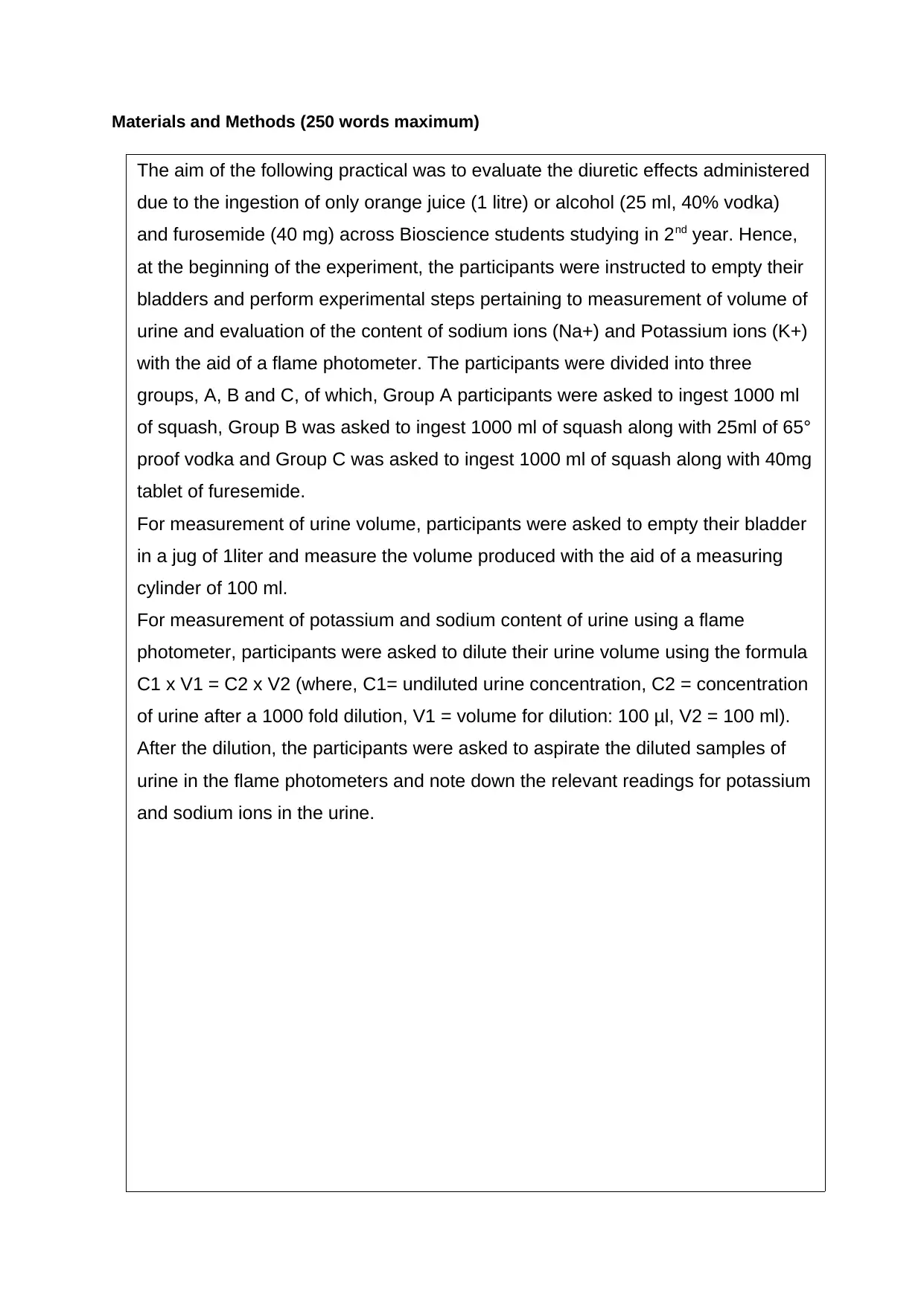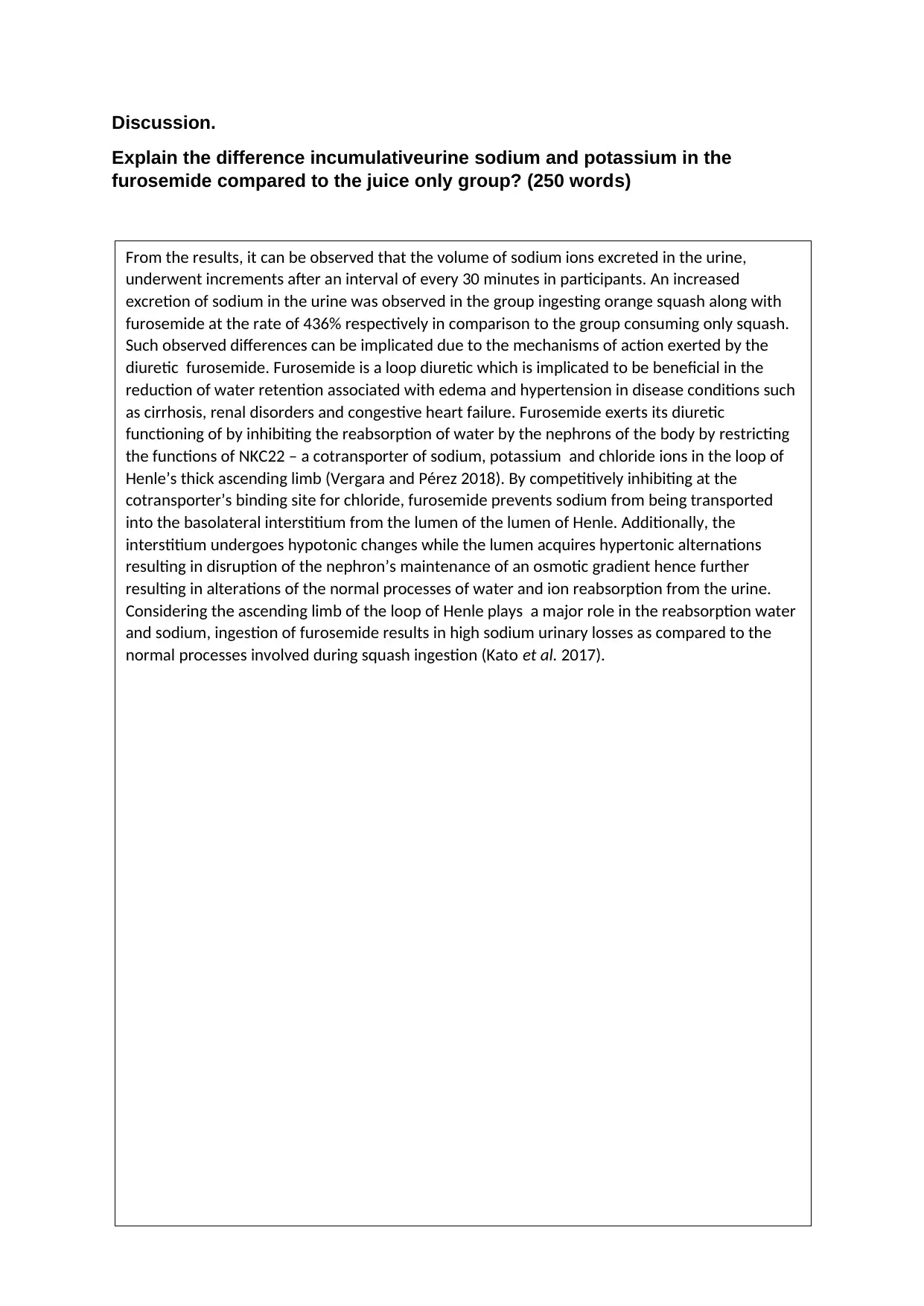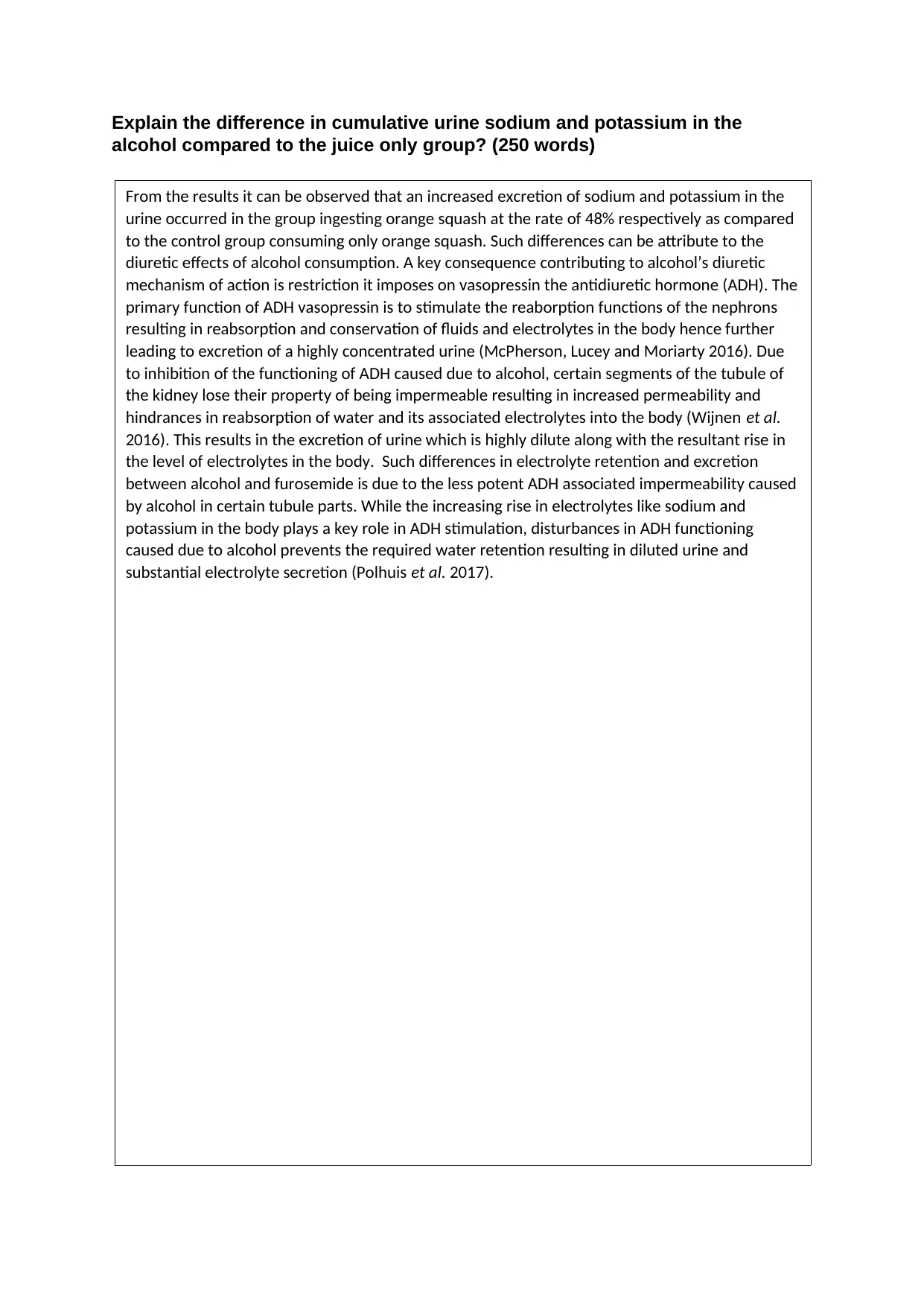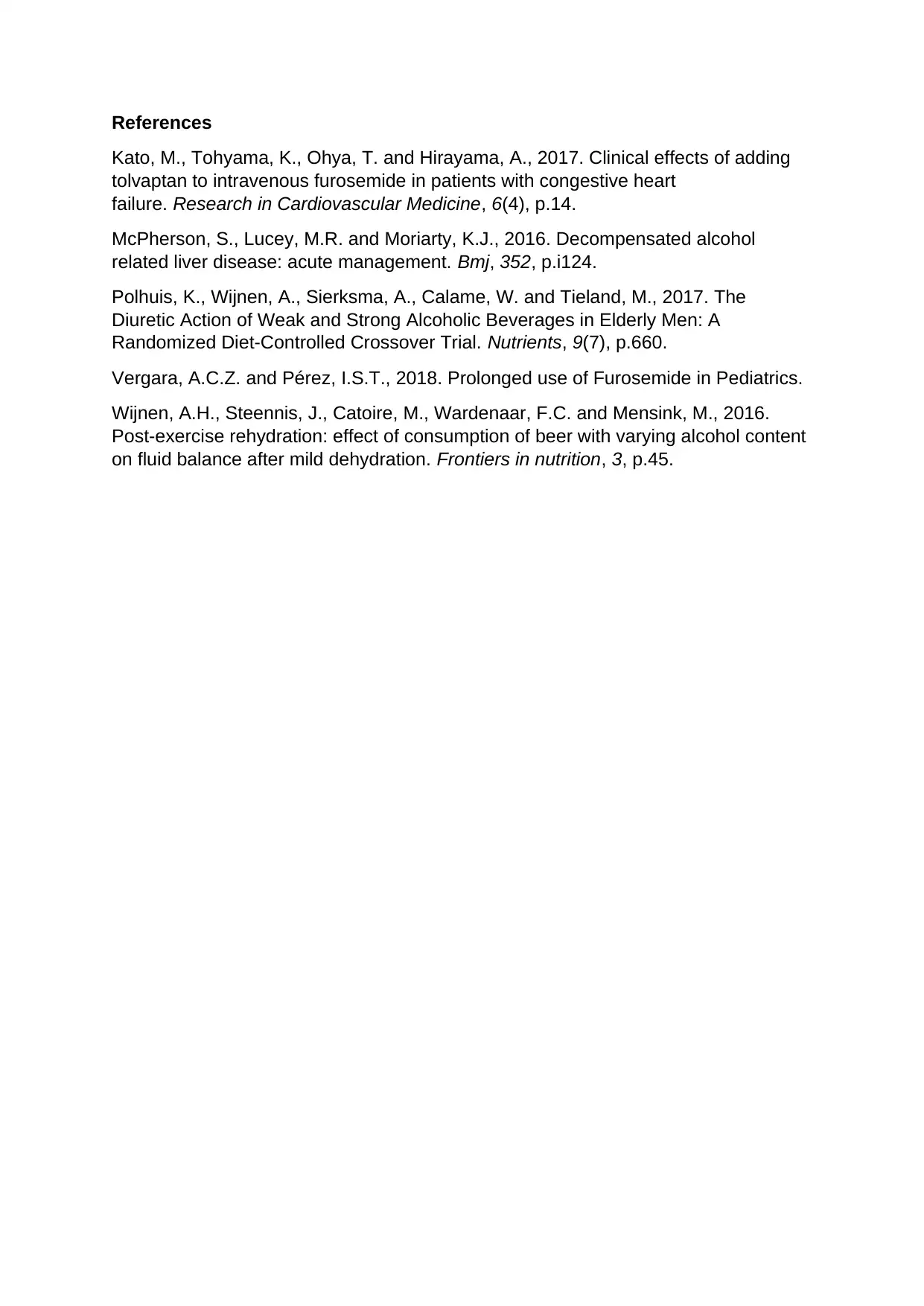BY266 Intermediate Human Physiology: Renal Function & Diuretics
VerifiedAdded on 2023/03/30
|5
|975
|111
Report
AI Summary
This report evaluates the diuretic effects of orange juice, alcohol, and furosemide on second-year Bioscience students. The study measured cumulative urine volume, sodium, and potassium excretion. The methods section details the experimental procedure, including the ingestion of substances and the measurement of urine volume and electrolyte content using a flame photometer. The discussion focuses on the differences in sodium and potassium excretion between the furosemide and juice-only groups, attributing the increased sodium excretion in the furosemide group to its mechanism of inhibiting the NKC2 cotransporter in the loop of Henle. Similarly, the report explains the differences between the alcohol and juice-only groups, noting alcohol's inhibition of vasopressin (ADH) leading to increased permeability and electrolyte excretion. The report references studies supporting these mechanisms, highlighting the role of furosemide and alcohol in altering renal function and electrolyte balance.

Intermediate Human Physiology (BY266)
Renal function lab class write-up template
Student No:
Renal function lab class write-up template
Student No:
Paraphrase This Document
Need a fresh take? Get an instant paraphrase of this document with our AI Paraphraser

Materials and Methods (250 words maximum)
The aim of the following practical was to evaluate the diuretic effects administered
due to the ingestion of only orange juice (1 litre) or alcohol (25 ml, 40% vodka)
and furosemide (40 mg) across Bioscience students studying in 2nd year. Hence,
at the beginning of the experiment, the participants were instructed to empty their
bladders and perform experimental steps pertaining to measurement of volume of
urine and evaluation of the content of sodium ions (Na+) and Potassium ions (K+)
with the aid of a flame photometer. The participants were divided into three
groups, A, B and C, of which, Group A participants were asked to ingest 1000 ml
of squash, Group B was asked to ingest 1000 ml of squash along with 25ml of 65°
proof vodka and Group C was asked to ingest 1000 ml of squash along with 40mg
tablet of furesemide.
For measurement of urine volume, participants were asked to empty their bladder
in a jug of 1liter and measure the volume produced with the aid of a measuring
cylinder of 100 ml.
For measurement of potassium and sodium content of urine using a flame
photometer, participants were asked to dilute their urine volume using the formula
C1 x V1 = C2 x V2 (where, C1= undiluted urine concentration, C2 = concentration
of urine after a 1000 fold dilution, V1 = volume for dilution: 100 μl, V2 = 100 ml).
After the dilution, the participants were asked to aspirate the diluted samples of
urine in the flame photometers and note down the relevant readings for potassium
and sodium ions in the urine.
The aim of the following practical was to evaluate the diuretic effects administered
due to the ingestion of only orange juice (1 litre) or alcohol (25 ml, 40% vodka)
and furosemide (40 mg) across Bioscience students studying in 2nd year. Hence,
at the beginning of the experiment, the participants were instructed to empty their
bladders and perform experimental steps pertaining to measurement of volume of
urine and evaluation of the content of sodium ions (Na+) and Potassium ions (K+)
with the aid of a flame photometer. The participants were divided into three
groups, A, B and C, of which, Group A participants were asked to ingest 1000 ml
of squash, Group B was asked to ingest 1000 ml of squash along with 25ml of 65°
proof vodka and Group C was asked to ingest 1000 ml of squash along with 40mg
tablet of furesemide.
For measurement of urine volume, participants were asked to empty their bladder
in a jug of 1liter and measure the volume produced with the aid of a measuring
cylinder of 100 ml.
For measurement of potassium and sodium content of urine using a flame
photometer, participants were asked to dilute their urine volume using the formula
C1 x V1 = C2 x V2 (where, C1= undiluted urine concentration, C2 = concentration
of urine after a 1000 fold dilution, V1 = volume for dilution: 100 μl, V2 = 100 ml).
After the dilution, the participants were asked to aspirate the diluted samples of
urine in the flame photometers and note down the relevant readings for potassium
and sodium ions in the urine.

Discussion.
Explain the difference incumulativeurine sodium and potassium in the
furosemide compared to the juice only group? (250 words)
From the results, it can be observed that the volume of sodium ions excreted in the urine,
underwent increments after an interval of every 30 minutes in participants. An increased
excretion of sodium in the urine was observed in the group ingesting orange squash along with
furosemide at the rate of 436% respectively in comparison to the group consuming only squash.
Such observed differences can be implicated due to the mechanisms of action exerted by the
diuretic furosemide. Furosemide is a loop diuretic which is implicated to be beneficial in the
reduction of water retention associated with edema and hypertension in disease conditions such
as cirrhosis, renal disorders and congestive heart failure. Furosemide exerts its diuretic
functioning of by inhibiting the reabsorption of water by the nephrons of the body by restricting
the functions of NKC22 – a cotransporter of sodium, potassium and chloride ions in the loop of
Henle’s thick ascending limb (Vergara and Pérez 2018). By competitively inhibiting at the
cotransporter’s binding site for chloride, furosemide prevents sodium from being transported
into the basolateral interstitium from the lumen of the lumen of Henle. Additionally, the
interstitium undergoes hypotonic changes while the lumen acquires hypertonic alternations
resulting in disruption of the nephron’s maintenance of an osmotic gradient hence further
resulting in alterations of the normal processes of water and ion reabsorption from the urine.
Considering the ascending limb of the loop of Henle plays a major role in the reabsorption water
and sodium, ingestion of furosemide results in high sodium urinary losses as compared to the
normal processes involved during squash ingestion (Kato et al. 2017).
Explain the difference incumulativeurine sodium and potassium in the
furosemide compared to the juice only group? (250 words)
From the results, it can be observed that the volume of sodium ions excreted in the urine,
underwent increments after an interval of every 30 minutes in participants. An increased
excretion of sodium in the urine was observed in the group ingesting orange squash along with
furosemide at the rate of 436% respectively in comparison to the group consuming only squash.
Such observed differences can be implicated due to the mechanisms of action exerted by the
diuretic furosemide. Furosemide is a loop diuretic which is implicated to be beneficial in the
reduction of water retention associated with edema and hypertension in disease conditions such
as cirrhosis, renal disorders and congestive heart failure. Furosemide exerts its diuretic
functioning of by inhibiting the reabsorption of water by the nephrons of the body by restricting
the functions of NKC22 – a cotransporter of sodium, potassium and chloride ions in the loop of
Henle’s thick ascending limb (Vergara and Pérez 2018). By competitively inhibiting at the
cotransporter’s binding site for chloride, furosemide prevents sodium from being transported
into the basolateral interstitium from the lumen of the lumen of Henle. Additionally, the
interstitium undergoes hypotonic changes while the lumen acquires hypertonic alternations
resulting in disruption of the nephron’s maintenance of an osmotic gradient hence further
resulting in alterations of the normal processes of water and ion reabsorption from the urine.
Considering the ascending limb of the loop of Henle plays a major role in the reabsorption water
and sodium, ingestion of furosemide results in high sodium urinary losses as compared to the
normal processes involved during squash ingestion (Kato et al. 2017).
⊘ This is a preview!⊘
Do you want full access?
Subscribe today to unlock all pages.

Trusted by 1+ million students worldwide

Explain the difference in cumulative urine sodium and potassium in the
alcohol compared to the juice only group? (250 words)
From the results it can be observed that an increased excretion of sodium and potassium in the
urine occurred in the group ingesting orange squash at the rate of 48% respectively as compared
to the control group consuming only orange squash. Such differences can be attribute to the
diuretic effects of alcohol consumption. A key consequence contributing to alcohol’s diuretic
mechanism of action is restriction it imposes on vasopressin the antidiuretic hormone (ADH). The
primary function of ADH vasopressin is to stimulate the reaborption functions of the nephrons
resulting in reabsorption and conservation of fluids and electrolytes in the body hence further
leading to excretion of a highly concentrated urine (McPherson, Lucey and Moriarty 2016). Due
to inhibition of the functioning of ADH caused due to alcohol, certain segments of the tubule of
the kidney lose their property of being impermeable resulting in increased permeability and
hindrances in reabsorption of water and its associated electrolytes into the body (Wijnen et al.
2016). This results in the excretion of urine which is highly dilute along with the resultant rise in
the level of electrolytes in the body. Such differences in electrolyte retention and excretion
between alcohol and furosemide is due to the less potent ADH associated impermeability caused
by alcohol in certain tubule parts. While the increasing rise in electrolytes like sodium and
potassium in the body plays a key role in ADH stimulation, disturbances in ADH functioning
caused due to alcohol prevents the required water retention resulting in diluted urine and
substantial electrolyte secretion (Polhuis et al. 2017).
alcohol compared to the juice only group? (250 words)
From the results it can be observed that an increased excretion of sodium and potassium in the
urine occurred in the group ingesting orange squash at the rate of 48% respectively as compared
to the control group consuming only orange squash. Such differences can be attribute to the
diuretic effects of alcohol consumption. A key consequence contributing to alcohol’s diuretic
mechanism of action is restriction it imposes on vasopressin the antidiuretic hormone (ADH). The
primary function of ADH vasopressin is to stimulate the reaborption functions of the nephrons
resulting in reabsorption and conservation of fluids and electrolytes in the body hence further
leading to excretion of a highly concentrated urine (McPherson, Lucey and Moriarty 2016). Due
to inhibition of the functioning of ADH caused due to alcohol, certain segments of the tubule of
the kidney lose their property of being impermeable resulting in increased permeability and
hindrances in reabsorption of water and its associated electrolytes into the body (Wijnen et al.
2016). This results in the excretion of urine which is highly dilute along with the resultant rise in
the level of electrolytes in the body. Such differences in electrolyte retention and excretion
between alcohol and furosemide is due to the less potent ADH associated impermeability caused
by alcohol in certain tubule parts. While the increasing rise in electrolytes like sodium and
potassium in the body plays a key role in ADH stimulation, disturbances in ADH functioning
caused due to alcohol prevents the required water retention resulting in diluted urine and
substantial electrolyte secretion (Polhuis et al. 2017).
Paraphrase This Document
Need a fresh take? Get an instant paraphrase of this document with our AI Paraphraser

References
Kato, M., Tohyama, K., Ohya, T. and Hirayama, A., 2017. Clinical effects of adding
tolvaptan to intravenous furosemide in patients with congestive heart
failure. Research in Cardiovascular Medicine, 6(4), p.14.
McPherson, S., Lucey, M.R. and Moriarty, K.J., 2016. Decompensated alcohol
related liver disease: acute management. Bmj, 352, p.i124.
Polhuis, K., Wijnen, A., Sierksma, A., Calame, W. and Tieland, M., 2017. The
Diuretic Action of Weak and Strong Alcoholic Beverages in Elderly Men: A
Randomized Diet-Controlled Crossover Trial. Nutrients, 9(7), p.660.
Vergara, A.C.Z. and Pérez, I.S.T., 2018. Prolonged use of Furosemide in Pediatrics.
Wijnen, A.H., Steennis, J., Catoire, M., Wardenaar, F.C. and Mensink, M., 2016.
Post-exercise rehydration: effect of consumption of beer with varying alcohol content
on fluid balance after mild dehydration. Frontiers in nutrition, 3, p.45.
Kato, M., Tohyama, K., Ohya, T. and Hirayama, A., 2017. Clinical effects of adding
tolvaptan to intravenous furosemide in patients with congestive heart
failure. Research in Cardiovascular Medicine, 6(4), p.14.
McPherson, S., Lucey, M.R. and Moriarty, K.J., 2016. Decompensated alcohol
related liver disease: acute management. Bmj, 352, p.i124.
Polhuis, K., Wijnen, A., Sierksma, A., Calame, W. and Tieland, M., 2017. The
Diuretic Action of Weak and Strong Alcoholic Beverages in Elderly Men: A
Randomized Diet-Controlled Crossover Trial. Nutrients, 9(7), p.660.
Vergara, A.C.Z. and Pérez, I.S.T., 2018. Prolonged use of Furosemide in Pediatrics.
Wijnen, A.H., Steennis, J., Catoire, M., Wardenaar, F.C. and Mensink, M., 2016.
Post-exercise rehydration: effect of consumption of beer with varying alcohol content
on fluid balance after mild dehydration. Frontiers in nutrition, 3, p.45.
1 out of 5
Your All-in-One AI-Powered Toolkit for Academic Success.
+13062052269
info@desklib.com
Available 24*7 on WhatsApp / Email
![[object Object]](/_next/static/media/star-bottom.7253800d.svg)
Unlock your academic potential
Copyright © 2020–2025 A2Z Services. All Rights Reserved. Developed and managed by ZUCOL.
